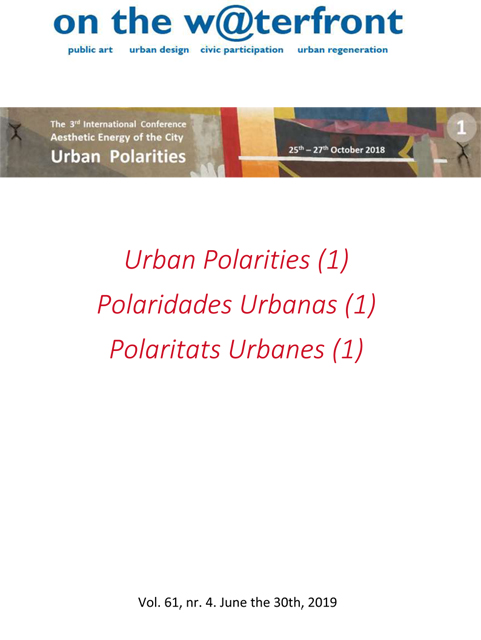El entorno de información de la creación estética de soluciones respetuosas con el medio ambiente y la aplicación de fuentes de energía alternativas en zonas suburbanas.
DOI:
https://doi.org/10.1344/waterfront2019.61.6.5Palabras clave:
entorno de información, energía renovable, afueras, estética de la tecnología, protección del paisajeResumen
Después de un período de fascinación por el hecho mismo de generar energías renovables baratas, estamos entrando en un período de búsqueda de soluciones que no solo serían útiles sino que también tendrían una forma atractiva. La sociedad de la información establece para los diseñadores la tarea de garantizar que las soluciones respetuosas con el medio ambiente se conviertan en parte estética de un sitio arquitectónico o de diseño urbano y no tengan un impacto adverso en el paisaje. El progreso tecnológico en la aplicación de técnicas digitales mejora en gran medida las herramientas del arquitecto en esta materia, ya que permite no solo el modelado de sistemas en el espacio virtual de la computadora, sino también la simulación de procesos en la búsqueda de soluciones óptimas, mientras mantiene el control del sistema. formar. Esta investigación tiene potencial para ser una herramienta que conduzca a la protección del paisaje cultural y natural. El objetivo de este artículo es analizar algunos de los logros recientes en el uso de la simulación por computadora, su utilidad para moldear y controlar el paisaje suburbano y, en particular, las soluciones que obtienen energía del sol.
Citas
ACKOFF, R. L. and SASIENi, M. (1968) Fundamentals of operations research. New York: Wiley.
GASPARSKI, W. (1988) Projektoznawstwo : elementy wiedzy o projektowaniu. Warszawa: Wydawnictwa Naukowo-Techniczne.
KOLAREVIC, B. and MALKAWI, A. M. (2005) Performative Architecture: Beyond Instrumentality. doi: 10.1111/j.1531-314X.2006.00068_1.x.
KOWAL, S. et al. (2017) ‘Digital Method for Verifying Archaeological Hypotheses. Medieval Gord Under Pułtusk Castle’, Studies in Digital Heritage. doi: 10.14434/sdh.v1i2.23412.
OLSSON, T. et al. (2012) ‘User evaluation of mobile augmented reality in architectural planning’, in eWork and eBusiness in Architecture, Engineering and Construction. doi: 10.1201/b12516-116.
PEREIRA, P. M. M., MONTEIRO, G. A. and PRAZERES, D. M. F. (2015) ‘General Aspects of Biomimetic Materials’, in PACHECO TORGAL, F. et al. (eds) Biotechnologies and Biomimetics for Civil Engineering. Cham: Springer International Publishing, pp. 57–79. doi: 10.1007/978-3-319-09287-4_3.
RIFKIN, J. (2012) ‘The Third Industrial Revolution- How Lateral Power Is Transform-ing Energy, The Economy, and the World’, World Future Review (World Future Society). doi: 978-0230341975.
SCHMITT, G. (1999) Information Architecture: Basics and Future of Caad. Birkhäuser--Publishers for Architecture (IT revolution in architecture). Available at: https://books.google.pl/books?id=5lMJ2uHt6J4C.
SŁYK, J. (2012) Źródła architektury informacyjnej. Warszawa: Oficyna Wydawnicza Politechniki Warszawskiej (Prace Naukowe Politechniki Warszawskiej. Seria Architektura 7).
SOWA, J. et al. (2017) Budynki o niemal zerowym zużyciu energii. Oficyna Wydawnicza PW.
TWAROWSKI, M. (1970) Słońce w architekturze. Wyd. 3. Warszawa: Arkady.
WRONA, S., MILLER, D. and KŁOS, J. (1996) Rola Informacji w Projektowaniu Architektonicznym. 0336/S1/93/04. Warszawa.
Descargas
Publicado
Cómo citar
Número
Sección
Licencia
 La licencia permite: Compartir: copiar y redistribuir el material en cualquier medio o formato y Adaptar: remezclar, transformar y construir a partir del material para cualquier propósito, incluso comercial. El licenciante no puede revocar estas libertades siempre que cumpla con los términos de la licencia. Los derechos de autor están protegidos por el ISSN 1139-7365. On the w@terfront no tiene restricciones respecto a los derechos de autor de los autores y permite a los autores retener los derechos de publicación sin restricciones.
La licencia permite: Compartir: copiar y redistribuir el material en cualquier medio o formato y Adaptar: remezclar, transformar y construir a partir del material para cualquier propósito, incluso comercial. El licenciante no puede revocar estas libertades siempre que cumpla con los términos de la licencia. Los derechos de autor están protegidos por el ISSN 1139-7365. On the w@terfront no tiene restricciones respecto a los derechos de autor de los autores y permite a los autores retener los derechos de publicación sin restricciones.
Esta revista no aplica ningún tipo de cargo a los autores por la presentación o procesamiento de los artículos.







